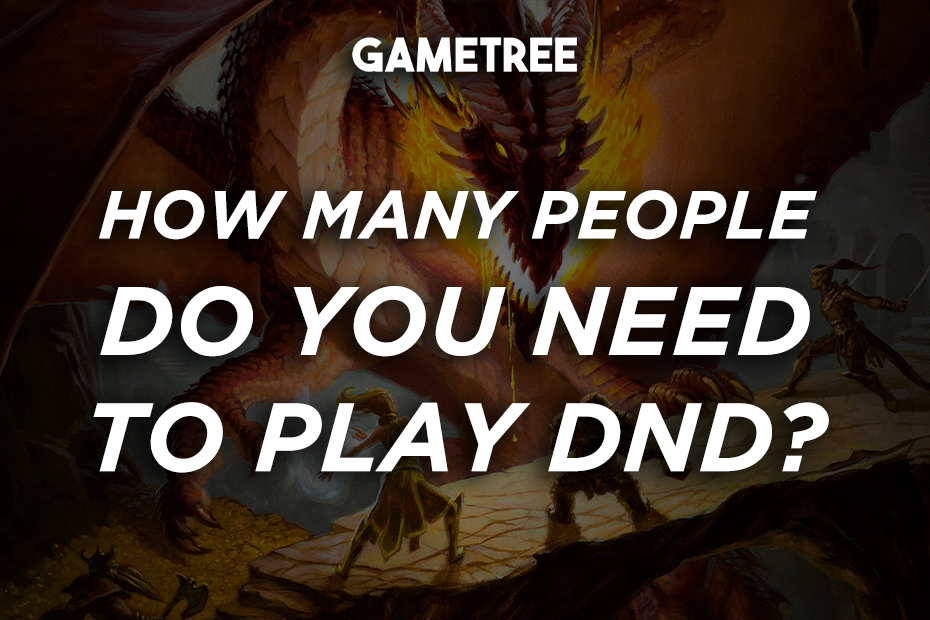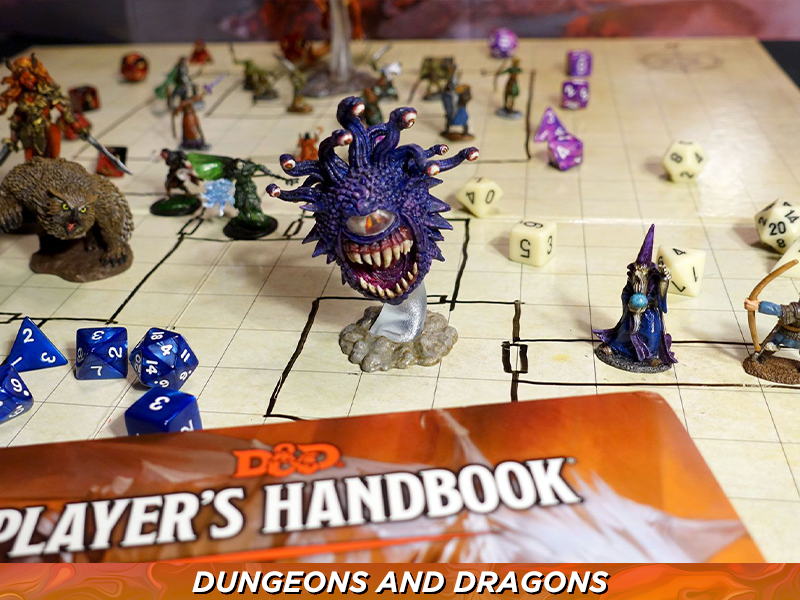How Many People Do You Need To Play Dungeons And Dragons And Have Fun

💡 Highlights
- Minimum of 2 people required: 1 player and 1 Dungeon Master.
- Ideal party size is typically 4 to 5 players, allowing for balanced gameplay and diverse interactions.
- D&D can accommodate up to 7 players or more plus the DM.
- Playing with fewer players (1-3) provides a more focused story and character development.
- Playing with more players (5+) offers rich social interactions and complex party dynamics.
- The most important aspect is having fun with the right party size for your preferences.
Whether you’re a seasoned adventurer or just stepping into the magical world of Dungeons and Dragons (D&D), one question always stands out: how many people do you need to play DnD and still have a good time? This article will shed some light on the various aspects related to the number of players in a D&D game and their impact on the gameplay experience.
You need a minimum of two people to play Dungeons and Dragons, one player, and one Dungeon Master. The ideal party size is typically 4 to 5 players, allowing for balanced game sessions and diverse player interactions.
How Many People Can Play DnD?
Let’s take a look what a simple session and a full campaign of DnD can look like while playing at different party sizes. We will try to find some pros and cons for playing each and every way.
Max And Min Number Of Players
As we mentioned above, the game of D&D can be played with a minimum of two players – one Dungeon Master (DM) and one player. However, D&D can accommodate a large group, even up to 7 players or more, apart from the DM. It’s the flexibility in player count that makes D&D an adaptable and inclusive role-playing game.
The Ideal DnD Party Size
The ideal DnD party size is typically 4 to 5 players. This size allows for balanced game sessions, engaging combat encounters, and diverse player interactions. The players can take on different character roles, ensuring that the group has a variety of abilities and skills to navigate the campaign’s challenges.
What Do I Need To Play Dungeons & Dragons?

To play Dungeons & Dragons, you need at least one player and one Dungeon Master. You’ll also need a Player’s Handbook, a set of polyhedral dice, character sheets for the players, and imagination. The DM will also require an adventure module or campaign setting to guide the story and encounters.
How Many People Do You Need For DnD: Comparing Gaming Options
Let’s jump right in! When people think of DnD they generally imagine a party exploring a dungeon together, but what if it’s just you and your Dungeon Master friend?
Single Player
Dungeons & Dragons is definitely not the first game that comes to one’s mind when thinking of the best solo board games, however D&D can be an intensely personal and compelling experience when played solo. As the sole protagonist of your adventure, the narrative is tailored to your character’s unique backstory and motivations. The DM can weave intricate narratives that center around you, providing a level of individual character spotlight that might be difficult in larger parties.
However, playing DnD solo lacks the camaraderie, inter-party dynamics, and interactive social encounters that a group game provides. It’s also worth noting that it can be a challenging experience for the DM, who has to single-handedly manage all aspects of the game world and NPCs.
Pros:
- A personalized and character-centric story
- More spotlight and focus on your character’s development
- Easier to schedule game sessions
Cons:
- Lacks the diversity and dynamics of a party
- Can be demanding for the DM to create an engaging solo campaign
- The lack of player interaction can be less immersive
D&D With 2 Players

A D&D game with two players and one DM is a step up from a solo game in terms of party dynamics. The game becomes more interactive with multiple player characters who can strategize together, share the spotlight, and assist each other in quests and combat encounters. It still provides a significant focus on individual character stories, and scheduling game sessions is typically easier with fewer players.
However, the game might still lack the variety and balance that larger parties offer. The limited number of player roles can make certain combat encounters more challenging and reduce the tactical decision-making possibilities in gameplay.
Pros:
- Increased focus on individual character stories
- More interactive gameplay with the added player
- Easier to schedule than larger parties
Cons:
- Limited party roles can make gameplay more challenging
- Less balanced gameplay with fewer skills and abilities in play
- Fewer social interactions compared to larger parties
D&D With 3 Players

Adding a third player to the party brings the game closer to traditional party dynamics. The players can take on a variety of roles, bringing a diverse range of skills and abilities to the table. This allows for more balanced gameplay and diverse player interactions.
However, it may still lack the depth of party roles seen in larger groups. While more balanced than a two-player game, the smaller party may still find some challenges daunting without a wider spread of abilities and character specializations.
Pros:
- More diverse party roles
- Better balanced gameplay with a wider range of abilities
- More player interaction adds to the depth of the game’s narrative
Cons:
- Some challenges may be more difficult without a full party
- Potentially less tactical depth than larger groups
- May require more scheduling coordination than smaller parties
D&D With 4 Players
A party of four players is often considered the sweet spot for D&D. This size allows for a diverse party composition, with players filling all the key roles needed for balanced gameplay. It allows for more complex character interactions and strategic decision-making in combat and role-playing situations.
However, coordinating schedules for four players can be more challenging. Also, as the number of players increases, so does the potential for player conflict, which the DM and players need to manage effectively.
Pros:
- Balanced and versatile party composition
- Engaging player interactions and role-play opportunities
- More tactical depth in gameplay
Cons:
- Requires more scheduling coordination
- Increased risk of player conflict
- Game sessions may run longer
D&D With 5 Players

A five-player party opens up the game even more, with a plethora of options for party composition. This allows for even more diverse character roles and a broader array of tactics in combat and problem-solving scenarios. It also brings more social interaction, adding depth and richness to the gaming experience.
However, managing a larger party requires careful balance by the DM. Game sessions might run longer, and combat encounters could slow down due to the increased number of participants.
Pros:
- Diverse party composition allows for versatile strategies
- Rich social interactions add depth to the gaming experience
- More character progression opportunities
Cons:
- Slower game pace due to more players taking turns
- Requires careful DM management to keep all players engaged
- Coordinating schedules becomes more challenging
D&D With 6 Players
With six players, D&D games can become truly epic in scope. The depth and variety of social interactions, along with complex party dynamics, create a rich and immersive gameplay experience. The increased complexity can lead to a high level of engagement and investment from the players.
However, managing such a large group can be a challenge even for an experienced DM. The pace of the game might slow considerably, especially during combat. Balancing encounters and quests for such a diverse party also requires careful planning.
Pros:
- Rich and complex social interactions
- High engagement and investment from players
- Epic scope of gameplay and party dynamics
Cons:
- Challenges in managing a large group
- Slower game pace and potentially long combat encounters
- Balancing encounters and quests becomes more complex
D&D With 7 Players Or More

Playing D&D with seven or more players can be a grand experience, providing unmatched depth in character interactions, party dynamics, and role-playing opportunities. It offers an abundance of tactical depth in both combat and non-combat situations.
The game of DnD doesn’t really have a max player number, however, large parties can be challenging to manage, both for the DM and the players. Keeping everyone engaged can be tough, and coordinating schedules can be a herculean task. Game sessions might run very long, and combat encounters could become slow and unwieldy.
Pros:
- Unmatched depth of character interactions and role-play opportunities
- Abundant tactical options and strategies
- Epic and grand scale of gameplay
Cons:
- Potentially challenging to manage and keep all players engaged
- Coordinating schedules can be extremely difficult
- Game pace can slow significantly, with long game sessions and combat encounters.
Need More D&D Players? Check Out GameTree for new friends and session mates!

Finding the right people to fill your D&D party doesn’t have to be an epic quest in itself. GameTree can help you find like-minded players who share your passion for D&D, facilitating connections and creating lasting friendships. With this social platform, you can easily recruit for your D&D campaign or join one that’s looking for players. Let GameTree make your D&D adventures even more exciting and memorable. Join today and start your D&D journey with the ideal party size!
Final Thoughts
Whether you’re a solo adventurer or part of a large crew, D&D offers a rich and immersive role-playing experience that is unmatched. The beauty of D&D lies in its flexibility, allowing you to tailor the game to fit your desired party size and play style. Remember, the most important aspect of D&D is having fun, so gather your party, grab your dice, and embark on your adventure!

Frequently Asked Questions
How Long Does It Take To Play Dungeons And Dragons?
A typical D&D session lasts about 3-4 hours, but the duration can vary greatly depending on the complexity of the game session and the preferences of the players and the DM.
How Many People Do You Need To Play DnD?
A minimum of two people is needed to play DnD: one player and one Dungeon Master.
Can You Play Dungeons And Dragons With 3 Players?
Yes, DnD can be played with 4 players. This setup allows for a balanced party dynamic and diverse gameplay interactions.
Is It Fun To Play DnD With Few Players?
Absolutely! Playing DnD with few players can lead to a more focused story and character development, offering a unique and enjoyable role-playing experience.
What Is The Ideal DnD Party Size?
The ideal DnD party size depends on personal preferences, but it's generally considered to be 4 to 5 players, offering a good balance of character roles and manageable group dynamics.
Can You Play DnD With 3 Players?
Yes, you can play Dungeons & Dragons (D&D) with three players, typically one acting as the Dungeon Master and the other two controlling player characters.




![Tabletop Gamers Crave More Play, But Life Keeps Getting in the Way [Infographic]](https://gametree.me/wp-content/uploads/2025/07/tabletop-infographic-thumb-statistics-300x126.png)









